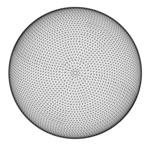LIMA model description
The Leibniz Institute Middle Atmosphere model
The LIMA (Leibniz Institute Middle Atmosphere) model is a general circulation model of the middle atmosphere, which has been redesigned from the COMMA model (Cologne Model of the Middle Atmosphere). LIMA is a non-linear, global Eulerian grid point model which extends from the ground to the lower thermosphere (150 km) using a vertical grid size of 1.1 km. LIMA includes modules for radiation and mesospheric chemistry-transport.
Horizontal grid structure
LIMA solves the atmospheric equations on a nearly triangular mesh, a so-called
reduced Gaussian grid, in horizontal direction. These fine mesh sizes of approximately 110 km enable LIMA to abandon the use of a gravity wave parametrization. LIMA resolves the surface of the global sphere with single grid points such that three adjacent points span triangles of similar size. LIMA does not use an exact triangle grid structure but an
approximation which is rather close to the reduced Gaussian ECMWF approach. We locate our longitudinal grid points on latitude circles which are equally spaced thereby modifying a perfect icosahedron structure. Figure A shows a realization of the LIMA triangle grid structure with a mesh size of approximately 270 km which means a total number of 6812 horizontal grid points.
The actual horizontal grid version of the operational version of LIMA has 41804 vertices on a sphere, the triangle edges have a size of approximately 110 km which is equivalent to a spectral resolution of T 120 at low latitudes. LIMA uses an Arakawa A grid type where all variables are placed at the triangle vertices. For future tasks we will also introduce Arakawa B or C types, where a second triangle mesh might be shifted from half to full latitudes.
Data assimilation
LIMA is combined with data from ECMWF (European Center for Medium-Range Weather Forecasts) by a simplified assimilation method. LIMA uses a continuous (every model time step) dynamical assimilation where forcing functions are added to the governing model equations to 'gradually' nudge the model state toward the observations. Nudging or Newtonian relaxation is a relatively simple but very flexible technique. For the real time representation of the state of the lower atmosphere we utilize the data provided through ECMWF analyses of temperature (T), zonal and meridional wind (u,v). Furthermore, the ECMWF surface geopotential is used as a lower boundary condition in LIMA. The ECMWF data used by LIMA is extracted with 1x1 degree resolution via the MARS archive for 21 pressure levels from 1000 to 1 hPa per every 6 hours at 0, 6, 12, and 18 UT. For periods before 2001 we use the ERA-40 data, afterwards we use the results of the operational model until present time. The actual ECMWF data are transferred once per day and after arrival the LIMA calculations automatically start. Figure B shows a snapshot of the assimilation procedure at a latitude circle of 53.5°N (Kühlungsborn) for January 10th, 2005 (0:00 UT). Through the relaxation of ECMWF data from the troposphere and lower stratosphere, the lower part of the atmosphere in LIMA is very close to reality and leads to highly variable wave patterns which propagate into the upper atmosphere.
Selected publications
- F.-J. Lübken, U. Berger and G. Baumgarten, Temperature trends in the midlatitude summer mesosphere, J. Geophys. Res., 118, 13347-13360, doi:10.1002/2013JD020576, 2013.
- F.-J. Lübken, U. Berger and G. Baumgarten, On the anthropogenic impact on long-term evolution of noctilucent clouds, Geophys. Res. Lett., 45, 6681-6689, doi:10.1029/2018GL077719, 2018.
Data assimilation














